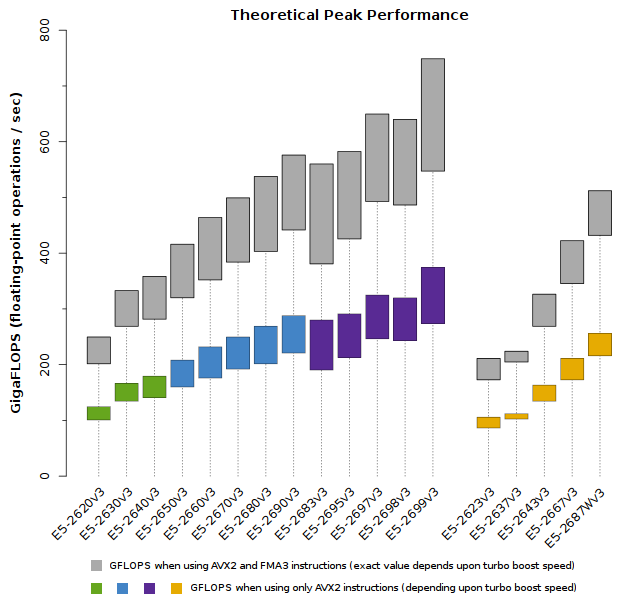We’re very excited to be delivering systems with the new Xeon E5-2600v3 and E5-1600v3 CPUs. If you are the type who loves microarchitecture details and compiler optimization, there’s a lot to gain. If you haven’t explored the latest techniques and instructions for optimization, it’s never a bad time to start.
Many end users don’t always see instruction changes as consequential. However, they can be absolutely critical to achieving optimal application performance. Here’s a comparison of Theoretical Peak Performance of the latest CPUs with and without FMA3:

Only a small set of codes will be capable of issuing almost exclusively FMA instructions (e.g., LINPACK). Achieved performance for well-parallelized & optimized applications is likely to fall between the grey and colored bars. Still, without employing a compiler optimized for FMA3 instructions, you are leaving significant potential performance of your Xeon E5-2600v3-based hardware purchase on the table.
Know your CPUs, know your instructions
With that in mind, we would like to summarize and link to these new resources from Intel:
Intel: Xeon E5-2600v3 Technical Overview
- A brief summary of Haswell-NI (Haswell New Instructions) that add dedicated instructions for signal processing, encryption, and math functions
- Summary of power improvements in the Haswell architecture
- Detailed comparison of C600 and C610 series chipsets
- Virtualization improvements and new security features
Intel: How AVX2 Improves Performance on Server Applications
- Instructions on how to recompile your code for AVX2 instructions and supported compilers
- Other methods of employing AVX2: Intel MKL, coding with intrinsic instructions, and assembly
- Summary of LINPACK performance gains delivered simply by using AVX2
Deliver the highest performance for your applications by taking of advantage of the latest the Intel architecture. For more information, contact a Microway HPC expert:
